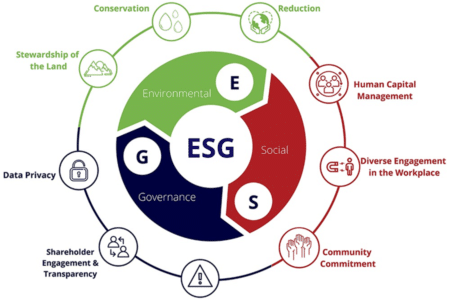Growing focus on, and successful practice of, ESG is being borne out by statistical evaluation.
Editor’s Note: Anjali Viswakumar leads Sustainability Services at Total EHS Advisory Services, LLP. In this article, she shares fundamentals of ESG, discusses international and national trends in the perception and reporting of ESG metrics, stresses its relevance to the elevator industry, and highlights the belief that adopting ESG practices could become a necessity for organizations moving forward.
Why ESG?
The focus on Environmental, Social and Governance (ESG) risks and ESG reporting by organizations has increased over the years, and the following statistics corroborate this:
Increasing risks in ESG affect the overall and long-term performance of organizations.
The Global Risks Report 2020, the 15th edition of the report by the World Economic Forum (WEF), lists the top risks as environmental and social, in terms of impact and likelihood for the year 2020. According to the WEF’s Global Risks Perception Survey 2019-2020, more than 85% of the global shapers felt that global warming/climate and water crisis risks would increase in 2020.
A global trend in ESG disclosure has improved company performances over the years.
- The industry-led initiative Principles for Responsible Investment (PRI), since its launch in 2006, now has nearly 2,000 signatories representing US$81.7 trillion in assets under management principles. Signatories commit to integrating ESG considerations into investment decision-making, ownership practices and reporting.
- The Global Reporting Initiative (GRI) reports that two decades ago, only a handful of businesses disclosed their environmental performance, but today, 93% of the world’s largest companies by revenue report information on their ESG, of which three quarters use the GRI framework.
What is ESG?
ESG data of an organization are the non-financial factors that can evaluate how far advanced or lagging an organization is on the sustainability graph.
ESG Factors Relevant to the Elevator Industry
E: Environment
This factor refers to an organization’s impact on the ecosystem. Other than major factors such as greenhouse gas emissions, air and water pollution and waste management, it also encompasses:
- Reducing the environmental impacts of its procurement, manufacturing and operational practices, such as using recycled materials in its manufacturing units and disposing of wastes as per standard norms
- Engaging energy-conservation measures in the elevator cab, machine and other components-manufacturing facilities in the industry
- Increasing usage of renewable energy in elevator-manufacturing facilities
- Manufacturing energy-efficient elevators that can contribute to sustainable living
- Promoting circularity in elevator product design, production and operation up to its end of life
- Developing greenbelt in and around the manufacturing facility operating areas
- Making optimal use of land and built-up space of its manufacturing and production facilities
- Procuring long-life and low-impact materials for manufacturing
- Reducing waste by effective usage of raw materials, fuel and other resources
- Engaging sustainable water consumption and effective use of recycled water
- Following proper solid waste and hazardous waste collection, segregation and management practices, especially in the use of oil and grease during elevator production and servicing of operational elevators
- Ensuring all above ESG norms apply to the manufacturer’s supply chain and to external providers that service the elevators once out of the OEM manufacturing premises
S: Social
Social factors address the relationship between the organization, its employees and other stakeholders. These factors include:
- Workforce diversity
- Human rights protection of workers
- Strong commitment against sexual harassment
- Reduced social impact of the product when sourcing raw materials and during manufacturing
- Operation and disposal
- Policies to eradicate workplace discrimination and gender in equality
- Ensuring health and safety in the workplace and also of its supply chain and external service providers
- Empowering local communities
G: Governance
Governance factors focus on corporate policies and how they are governed. It’s about first understanding and then taking credible steps to ensure that the stakeholders’ needs are understood and met. Some governance factors include:
- Achieving diversity and gender equality on the governing board
- Assuring transparency in reporting of financial and non-financial disclosures
- Eliminating corruption inside the business
- Assessing and implementing the decisions of interested parties
- Creating a long-term value for business by adapting to the changes in economic, environmental and social conditions
- Managing risk
Some of the globally recognized voluntary ESG disclosure frameworks are United Nations Principles of Responsible Investment (UNPRI), GRI, Carbon Disclosure Project (CDP), Sustainability Accounting Standards Board (SASB) and Dow Jones Sustainability Indices (DJSI).
The Indian ESG Landscape
In the last decade, there have been quite a few policy reforms in India that have urged corporations to move toward voluntary, and now mandatory, ESG disclosures. The above timeline illustrates the transition from the National Voluntary Guidelines, 2011 to 2020, where the top 1,000 listed companies (by market capitalization) are now required to publish a Business Responsibility & Sustainability Reporting (BRSR) report, along with their annual report starting in FY 2022-23.
In brief, the latest is:
- Companies following the Business Responsibility Reporting (BRR) format of reporting now need to transition to additional reporting of BRSR requirements required by the Security and Exchange Board of India
- Top-listed companies should be assessing their preparedness for this transition
- BRSR disclosure by companies would require them to develop a quantitative approach over the BRR checklist approach to articulate the values of the company, along with their economic growth.
Way Forward in the Elevator Industry
With a greater influx into urban areas and an estimated seven billion elevator rides taking place daily in high-rise buildings around the world, it is becoming inevitable for the elevator industry to strategize its growth with a focus on sustainability. The pandemic has been a real test of companies’ and industries’ resilience to adversity. Holistic growth of the company that addresses all such risks will be the practical way forward. Evaluating, strategizing and implementing and, finally, monitoring and reporting a company’s ESG performance will be key steps in this journey of sustainability.
Top elevator-industry companies have already committed to ESG goals and organization-wide implementation of ESG practices. Organizations that fail to act on ESG will invariably face greater risks and miss significant opportunities compared to ESG leaders in key areas, ranging from better access to capital, a better reputation and brand image, to operational improvement and pursuit of new business ventures.


References
[1] World Economic Forum, 2020, “The Global Risks Report 2020,” 15th Edition
[2] Joe McGrath, 5 March 2019, “Understanding the Evolution of ESG,” published in ESGCLARITY
[3] GRI, 20 March 2019, “Sustainability Reporting – 20 Years on and More Relevant Than Ever”
[4] youmatter.world/en/definition/definitions-esg-what-is-it-definition-principles-and-examples/; accessed on 15 June 2021
[5] Yes Bank, December 2019, “ESG Investing Scenario in India — Co-creating a better future”
[6] Harvard Law School Forum on Corporate Governance, 2 March 2020, “Top 10 ESG Trends for the New Decade,” Posted by Kosmas Papadopoulos and Rodolfo Araujo, FTI Consulting
Get more of Elevator World. Sign up for our free e-newsletter.






